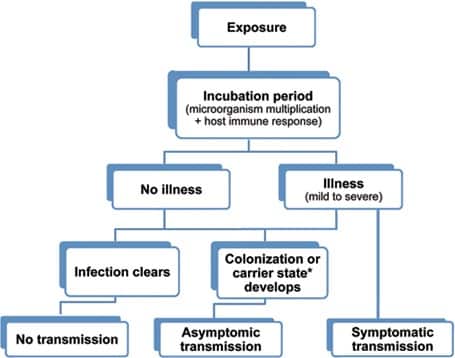
The chart is not specific to any particular disease. Since it starts with “exposure” and ends with three phrases that all use the word “transmission,” the diagram is logically used to determine whether exposure to disease will lead to disease transmission.
Hydrogen bonds form between the bases to stabilize the double helix structure of DNA.
While the entirety of an atom’s nucleus contains neutrons, protons, and electrons, only the neutrons and protons are found inside of the nucleus. Electrons exist as a cloud surrounding the nucleus and thus are not found inside it.
There is always a decrease in the amount of energy transferred from lower trophic levels to higher trophic levels. In general, the higher the trophic level of the consumer, the less overall available energy. Primary consumers have more energy available than both secondary and tertiary consumers.
When light hits an object, the object absorbs some of the light and reflects the rest of it. The wavelengths that are reflected determine how our eye perceives the color. We see a red dress as “red” because those wavelengths are reflected and not absorbed.
In an experiment, an “independent variable” is a factor controlled by the scientists. A "dependent variable" represents the output or effect. Since the light is controlled by the experimenters, it is an independent variable.
The endocrine system is the collection of glands that regulate metabolism, growth and development, tissue function, sexual function, reproduction, sleep and mood, among other things. Also ‘Regulating’ is a big hint in this problem.
Advertisement
More massive objects will only free-fall faster than smaller objects if there is a significant amount of air resistance present. For a penny and an elephant that are free-falling in a vacuum, the rate of acceleration would be the same, so both would fall at the acceleration due to gravity which is 9.8m/s2.
The momentum of an object is equal to the mass of the object times the velocity of the object. The largest momentum from these choices comes from 9500 x 200 = 1.9 million.
On the x-axis, 75 days corresponds to roughly 20% on the y-axis. Since about 20% of the methuselah flies survive after 75 days, the probability of one fly’s survival is 1/5.
Although the correlation is not strong, it appears that the price increases as the quality increases. This describes a weak direct correlation.
Mitosis produces two diploid daughter cells that have the same genetic material as the original mother cell.
All three animals belong to the same kingdom of Animalia, but are too different to be classed in the same phylum. Cheetahs and rainbow trout are in the Chordata phylum, while inchworms are in Arthropoda phylum.
Advertisement
ANP, or Atrial Natiuretic Peptide is a hormone released in response to increased blood volume and pressure that produces vasodilation. As a consequence of this vasodilation, the excretion of both sodium and water increases in order to return to the homeostatic conditions prior to increased blood volume and pressure. Because excretion of water increases, ANP causes a decrease in water retention and not an increase.
Through the mouth, food enters the digestive tract where it is masticated (chewed) and starts to break down due to salivary amylase. The meal, which is now referred to as the "bolus," is swallowed with the help of the epiglottis, a cartilaginous flap that closes over the trachea, and is subsequently moved to the stomach by esophageal muscular contractions. The bolus is mostly chemically digested in the stomach, where it is liquefied into chyme and then transferred to the duodenum of the small intestine. Most nutrient absorption takes place in the duodenum of the small intestine.
Food is ingested through the mouth, where it is masticated (chewed) and starts to break down due to salivary amylase. The meal, which is now referred to as the "bolus," is swallowed by the trachea-covering cartilaginous flap known as the epiglottis, and is subsequently moved to the stomach by esophageal muscular contractions. The stomach is where the bolus undergoes most of its chemical digestion, liquefying it into chyme that is then sent to the duodenum of the small intestine. The majority of nutritional absorption happens in the duodenum of the small intestine.
There are bare, unmyelinated areas in the axon's myelin sheath. Nodes of Ranvier are the name given to these areas. The electrical impulse "jumps" from node to node when an action potential extends down an axon.
To drive the air out of the lungs during exhalation, the air pressure in the lungs must rise above the atmospheric pressure. The diaphragm opens up and relaxes in order to raise pleural pressure.
Damaged cells generate chemical signals that draw white blood cells to the affected location during an inflammatory reaction. The most common cause of these symptoms is histamines, which render the capillaries in the area "leaky" or permeable, allowing phagocytic white blood cells to leave the blood vessel and travel to the damaged area to consume any dead cells or debris that has entered the area.
Infant mortality has declined in most industrialized nations as a result of giving women access to better education and birth control options.
Click for next FREE TEAS Test
TEAS Science Practice Test #3